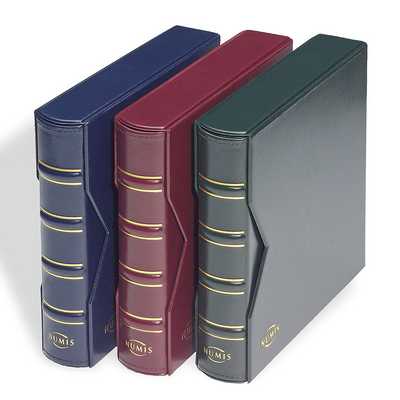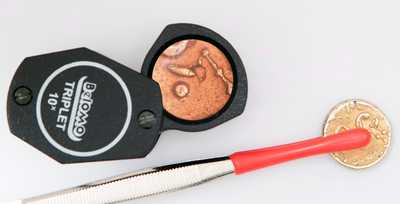Assuming you’re now hooked on ancient coins, and perhaps have one winging its way to you in the post, here are some of the other items you might need. Most of these are ones that I own and use.
Storage & Display
I started out using an album to store my collection, but have now switched to trays. The albums are a relatively cheap way to store large numbers of coins, but it can be tricky to get the coins out of the pockets, and I’m someone who likes holding my coins. Trays make it easy to access the coins. They are bulkier though, so might be limiting if you intend to have a large collection in a small space.
 | I used a Lighthouse NUMIS album with the following inserts:
|
I now use NOVA stacking trays for my collection because I think they look better and because I can now pick my coins up without a fight.
I use the Nova 6317 tray, with 80 square 17mm spaces, for my quarter staters, and the Nova 6326 tray, with 35 circular 26mm spaces, for my staters and drachms. These trays come in a variety of shapes and sizes. For example, if you wanted square holes for your staters then the Nova 6327 tray (35 square 27mm spaces) is available. |  |
Finally, I use a floating frame if I ever want to have some coins on display. This works well for most of my coins, although some just slip to the bottom of the frame.
Loupe & Tongs
Although it’s perfectly acceptable to pick up ancient coins with your fingers (as long as they’re clean), it’s sometimes easier to get a grip using a pair of coin tongs, which are just tweezers with rubber tips. This is particularly true if you store your coins in an album. I use these tongs, which are relatively cheap (I paid £3.79 including postage).
 | A loupe is useful if you want to see your coins up close. I have two loupes. The first claims to have x10 magnification, and it’s the one I use the most. The optical quality is good, and it has a range that will let me view the entire coin shown in the picture in one go, or zoom in to the level shown in the picture. There are probably better loupes available, but this one does me just fine. |
I have a second loupe that claims to have x30 and x60 magnification, although I’m fairly certain these numbers are just made up. The x30 lens doesn’t seem to magnify much more than the x10 loupe, and the quality is a little bit worse (still good enough though). The x60 lens, regardless of the actual magnification, lets me see the coins in great detail. It has LED lighting which is important for the x60 lens, because you’re so close to the surface of the coin that not much ambient light will get in. It’s hard to keep things in focus at this magnification, and that, combined with the glare from the light, means I can only use this for a short period of time. It’s good enough quality for the price, and I’d buy it again, but if cost isn’t a problem for you then you might be better getting the x10 loupe and a proper good quality microscope (this is mine and it’s absolutely fantastic. Remember to buy a light for it as well).
Scales
Knowing the weight of a coin can be important in order to identify forgeries, and to sometimes identify the coin itself. For example, classes 4H and 4L of Gallo-Belgic E are differentiated solely by weight. If you are posting a coin for sale, serious collectors will ask you for the weight. There are a large number of near identical scales available on eBay and Amazon which all seem to come from the same factory. I bought these ones from eBay and they work just fine.
Coin Tickets
A coin ticket is a piece of thick white paper (normally round) that you write information about the coin on and store with your coin. You can pick them up on eBay, but I make my own because the size I need (15mm) for my quarter stater coin tray doesn’t seem to exist. I also need to be sure that the paper is acid free so that it doesn’t damage the coins over time, and that it works with my small nibbed pens. These are necessary because the tickets are so small, but the nibs are easily damaged and become irreparably blocked if the paper isn’t quite right.
I use the following pens and paper, which work well together (I found out the expensive way that not all papers are equal when it comes to these pens):
Sakura Pigma Micron Fineliners – 0.5mm in Black, Blue, Red, and Green
The Sakura fineliners work just fine but the Copic is a nice luxury. It has replaceable nibs which is useful because they are fragile at this size. I bought this 8mm, 15mm and 25mm punch set to make the tickets and gave the 8mm one to my daughter.
Photography
It’s possibly to get good enough photos of your coins with your phone, but it you want to take high definition photos then I’d recommend getting some specialised gear. Be warned that this bit might get expensive. I’ll start with the cheap stuff.
Gray/White/Black colour balance cards. These are dirt cheap and let you easily colour balance your photos so you can get accurate colours. They also make great little backgrounds for the coins, and can be used to reflect light onto your coins, or block light to get rid of reflections.
This lightbox is inexpensive and works well. It comes with a selection of backgrounds that I don’t use, and two LED strips which I use all the time.
My macro focusing rail is no longer available, but it looks exactly like this one. I’m pretty sure it’s the same one but just rebranded. It works just fine for the price but I’d buy the Novoflex CASTEL–CROSS focusing rack or the Novoflex CASTEL-MICRO Stepping Motor Controlled Focusing Rack if I could justify it.
Getting close-ups of your coins requires a macro lens. I use a Canon EF 100MM F2.8 Macro USM lens with Kenko Teleplus extension tubes.
You’ll also need a camera (any modern DSLR camera will be good enough), and some way of holding the camera. I use a tripod because I have one, but I’d recommend getting a copy stand instead. The tripod takes up a lot of floor space when set up, and getting the camera to point straight down is awkward.
Whatever you buy, don’t buy cheap if you can afford not to. At macro distances the smallest vibrations become significant, and focusing the camera requires tiny movements. The more you spend, the less frustrating it will be.
